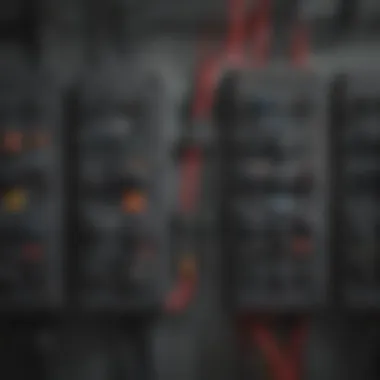Understanding Circuit Breakers: Troubleshooting Tips


Intro
Living in a modern home requires an understanding of various components that keep it functioning safely and effectively. One of the crucial elements in our electrical systems is the circuit breaker. These devices protect our homes from electrical overloads and short circuits. However, when a circuit breaker trips and cannot be reset, it becomes a problematic issue that needs immediate attention.
This guide aims to shed light on the functionality of circuit breakers, their common failure points, and practical troubleshooting steps homeowners can follow. Understanding these nuances not only enhances safety but also empowers individuals to take informed actions in maintaining their home’s electrical systems.
Feature Spotlight
Importance of Circuit Breakers
Circuit breakers serve a fundamental role in electrical systems by interrupting the flow of electricity when a fault is detected. Their primary function is to provide safety by preventing overheating and potential fire hazards.
- Overload: Occurs when too many devices draw power, exceeding the breaker's limit.
- Short Circuit: Happens when there is a direct connection between the wires, causing excessive current flow.
- Ground Fault: This results when electricity seeks a path to the ground, increasing the risk of shock.
Recognizing the warning signs of these issues is vital in preventing larger electrical problems.
"Understanding the role of circuit breakers can save lives and property."
Key Reasons for Tripping
Various factors can cause circuit breakers to trip. Here are some key reasons:
- Faulty appliances
- Wire connections that are loose
- Wet or damp conditions
- Electrical surges from external sources
By identifying these causes, homeowners can narrow down issues related to their circuit breakers and implement corrective measures quickly.
Troubleshooting Steps
When a circuit breaker has tripped and cannot be reset, it’s essential to approach the situation methodically:
- Identify the Tripped Breaker: Check the electrical panel. Look for switches that are in the off position or in a halfway position.
- Disconnect Appliances: Unplug appliances that are connected to the affected circuit before trying to reset. This reduces the load on the circuit.
- Inspect for Visible Issues: Look for signs of burning, melted insulation, or water damage near the breaker or outlets.
- Reset the Breaker: Once the circuit is clear, reset the breaker by moving the switch fully to the ‘OFF’ position and then back to ‘ON’.
- Monitor the情况: If the breaker trips again, do not attempt to reset it multiple times. Seek professional help.
Following these systematic steps can lead to the identification of a simple fix or alert homeowners to the need for professional intervention.
Finale
Circuit breakers are essential safeguards in our homes. Understanding their operation, the reasons they trip, and how to troubleshoot issues can significantly affect home safety and longevity. Equipped with this knowledge, homeowners can make informed decisions about their electrical systems, ensuring a safer living environment.
For further understanding, consider looking into resources such as Wikipedia or Britannica for in-depth information.
Preamble to Circuit Breakers
Circuit breakers are essential components in modern electrical systems. They serve as a protective device that automatically interrupts the flow of electricity in the event of a fault. Understanding their function and importance is crucial for homeowners and anyone interested in electrical maintenance. The primary role of a circuit breaker is to prevent damage to wiring and appliances caused by overloads or short circuits. Without circuit breakers, electrical fires and equipment failures would be more common.
One of the significant benefits of circuit breakers is their ability to provide immediate feedback to users. When a circuit trips, it indicates that there is an issue requiring attention. Recognizing this early can prevent further damage and ensure safety within the home. Additionally, circuit breakers offer a level of control over an electrical system that fuses do not.
Moreover, the widespread use of circuit breakers in residential homes has brought about considerations around safety and convenience. They can be easily reset, eliminating the need for replacement like traditional fuses. This attribute encourages users to take a more hands-on approach when dealing with simple electrical issues, thus fostering a better understanding of their electrical systems.
In this article, we will explore the various aspects of circuit breakers, including their functionality, the reasons they trip, methods for troubleshooting, and safety protocols. By providing detailed insights, this guide aims to enhance your knowledge of circuit breakers and their role in home safety.
"A circuit breaker acts as the guardian of your electrical system, preserving both the infrastructure and the devices connected to it."
This foundational understanding sets the tone for the ensuing sections, where deeper examination into specific topics surrounding circuit breakers will be discussed.
Functionality of Circuit Breakers
Understanding the functionality of circuit breakers is essential for anyone interested in home electrical systems. Circuit breakers protect electrical circuits from overloads and other faults, ensuring both safety and reliability in electrical installations. When they operate correctly, they keep fires and equipment damage at bay.
When a circuit breaker trips, it interrupts the flow of electricity, preventing potential hazards. Resetting the breaker might seem like a simple task, but knowing its functionality helps in addressing underlying issues that cause repeated tripping. An unresponsive circuit breaker can suggest deeper problems, which may need thorough investigation.


How Circuit Breakers Operate
Circuit breakers function using a mechanical switch that opens or closes based on electrical flow. When the current exceeds a certain limit, the switch opens, stopping the electricity flow to prevent overheating. This mechanism is crucial for protecting both household appliances and the overall electrical system.
Most circuit breakers have two primary operating mechanisms: thermal and magnetic.
- Thermal operation relies on heat generated by excess current. A bimetallic strip bends at high temperatures, activating the switch to break the circuit.
- Magnetic operation uses an electromagnet that dips into the circuit at high currents, pulling the switch open almost instantaneously.
Both mechanisms work effectively but differ in the speed of response. Understanding these operations can help troubleshoot why a breaker might not reset after tripping.
Types of Circuit Breakers
Circuit breakers come in various types, each tailored for different applications:
- Standard Circuit Breakers: Common in residential settings, these provide basic overcurrent protection.
- GFCI (Ground Fault Circuit Interrupter): Designed to protect against ground faults, these breakers are essential in wet areas like bathrooms and kitchens.
- AFCI (Arc Fault Circuit Interrupter): These detect dangerous arcing conditions which may lead to electrical fires, suitable for bedrooms and living areas.
- Dual Function Breakers: Combine the features of both GFCI and AFCI, offering comprehensive protection.
Selecting the appropriate type of circuit breaker is critical for ensuring safety and compliance with electrical codes. Each type addresses specific risks, enabling homeowners to maintain safer living environments.
Common Reasons for Circuit Breaker Trips
Understanding the common reasons for circuit breaker trips is essential for both safety and effective home maintenance. When a circuit breaker trips, it serves as a warning sign that something is amiss in the electrical system. Ignoring these alerts can lead to significant hazards, including electrical fires or damage to appliances. By knowing these common reasons, homeowners can take proactive measures to prevent future incidents, ultimately saving time and money while ensuring safety in their living environments.
Overcurrents and Overloads
Overcurrents occur when the electrical current exceeds the rated capacity of the circuit. This usually stems from too many devices drawing power simultaneously. Appliances like space heaters, air conditioners, and refrigerators can notably contribute to this issue. When the demand surpasses safe levels, the circuit breaker trips to prevent overheating and potential fire hazards.
Overloads can sometimes be tricky to identify. They may happen gradually, leading homeowners to underestimate their circuit's capacity. If several devices are attached to a single circuit, the combined demand can easily exceed its limit. Regularly reviewing which appliances are connected can help manage this issue effectively.
Key considerations for avoiding overcurrents:
- Distribute Load: Avoid plugging multiple high-wattage devices into the same circuit.
- Check Ratings: Understand the ampacity of each circuit and the power requirements of your devices.
Short Circuits Explained
A short circuit occurs when the electrical current finds an unintended path, leading to excessive flow. This can happen due to damaged wiring or faulty appliances. For instance, if an exposed wire contacts a grounded surface, it creates a low-resistance path, causing the breaker to trip swiftly. The quick action of the circuit breaker serves to prevent severe damage or fires, underscoring its vital safety role.
Identifying a short circuit can be challenging without the right tools. Homeowners should look out for signs such as:
- Burning Smell: The presence of an electrical smell indicates overheating.
- Flickering Lights: Random flickering can be a sign of irregular power flow.
Preventing short circuits requires vigilance in maintaining wiring integrity and appliance condition.
Ground Faults and Their Impact
Ground faults occur when the electrical current diverts to the ground, usually through faulty insulation or wet conditions. This problem is particularly relevant in areas of the home such as bathrooms or kitchens where moisture is common. Ground fault circuit interrupters (GFCIs) are designed to protect against these faults by cutting off the current immediately when a fault is detected.
Understanding the potential impacts of ground faults is critical:
- Shock Hazards: Direct contact with current can result in serious injuries or fatalities.
- Equipment Damage: Appliances can be adversely affected, leading to costly repairs or replacements.
To mitigate risks related to ground faults:
- Install GFCIs: Ensure GFCIs are in place in high-risk areas.
- Regular Inspections: Periodically inspect appliances and outlets for any signs of wear or damage.
Recognizing these core reasons for circuit breaker trips can enable homeowners to take preventive actions, enhancing household safety and electrical efficiency.
What Happens When a Breaker Trips
When a circuit breaker trips, it is a critical event in any electrical system. Understanding what happens during this process helps in preventing potential damage and ensuring safety. A circuit breaker serves as a protective device, designed to interrupt the flow of electricity when certain faults occur. But what exactly happens when it trips and why is it important to know this? This section delves into the immediate effects on electrical systems and the necessity of resetting the breaker.
Immediate Effects on Electrical Systems


The moment a circuit breaker trips, several key effects take place:
- Power Interruption: The most immediate effect of a tripped breaker is the loss of electrical power in the affected circuit. This cutoff can impact various appliances and devices, leading to disruption in daily activities.
- Protection Against Overload: The tripping action serves to protect the wiring and appliances from the damages caused by overloads. This mechanism prevents wires from overheating, which might otherwise lead to fire hazards.
- Disconnection from Power Source: Physically, the circuit breaker disconnects itself from the power source, preventing any current from flowing through the circuit. This is vital for the safety of the entire electrical system.
- Potential Triggers for Other Systems: In cases where multiple circuits share a connection, one tripping breaker might amplify pressure on others, leading to a cascading effect of interruptions.
- Indicator of Faults: A tripped breaker often indicates underlying issues, whether it be an overload, short circuit, or ground fault. Addressing these faults promptly can prevent recurring problems and improve system reliability.
"A trip is not merely an inconvenience; it’s an essential warning sign from the electrical system that requires immediate attention."
Importance of Resetting
Resetting a circuit breaker is essential for restoring electrical service and ensuring ongoing safety. Here’s why this step holds significance:
- Restoring Power: After addressing the cause of the trip, resetting allows electrical flow to resume. This is crucial for the functioning of home appliances and lighting.
- Confirmation of Issue Resolution: A successful reset often indicates that the underlying issue has been resolved. If the breaker trips again without any apparent changes, further investigation is warranted.
- Malfunction Awareness: Frequent tripping without apparent cause can signal deeper electrical issues. In such cases, resetting alone is not sufficient, as ignoring signs can lead to larger problems.
- Operational Integrity: Regularly resetting a breaker promotes the health of the electrical system. It ensures that circuits operate within their intended parameters, maintaining both performance and safety standards.
- User Knowledge: Understanding how and when to reset a breaker empowers homeowners to take control of their electrical systems. This knowledge reduces reliance on professionals in minor situations, alongside promoting confidence and safety in one’s home.
In summary, recognizing the implications of a tripped breaker and the importance of resetting creates a foundation for responsible electrical management. This comprehension not only aids in effective troubleshooting but also ensures that subsequent electrical operations are safe and efficient.
Troubleshooting Steps When Breaker Will Not Reset
Troubleshooting when a circuit breaker will not reset is a critical part of maintaining electrical safety in a home. Understanding these steps illuminates important aspects of how electrical systems function, and can prevent potential hazards. A breaker that remains tripped signals an underlying issue. Addressing problems promptly can save homeowners from more severe electrical risks and costly repairs.
Inspecting the Electrical Load
The first step in troubleshooting is to inspect the electrical load on the circuit. Overloading occurs when devices demand more power than the circuit can handle. To assess the situation, start by creating a list of all devices connected to the circuit in question. Look for high-wattage appliances like heaters, air conditioners, or power tools. These often exceed safe limits.
- Disconnect Devices: Safely unplug all equipment connected to the affected circuit.
- Check Ratings: Examine the circuit breaker’s amp rating. Verify that the sum total of devices does not surpass this rating. If it does, reducing the number of devices on the circuit may resolve the issue.
- Use a Multimeter: For a more thorough inspection, a multimeter can measure current draw from individual devices. This gives a clearer picture of load distribution.
If the electrical load seems appropriate, other factors may need to be investigated further.
Testing for Short Circuits
Short circuits happen when electricity flows through an unintended path. These faults can cause circuit breakers to trip repeatedly when trying to reset. To test for a short circuit, several steps should be taken:
- Visual Inspection: Look for frayed wires, loose connections, or burn marks in the electrical panel.
- Use a Circuit Tester: Utilize a circuit tester to identify if there’s continuous current flowing where it shouldn’t. Ensure that the power is turned off before conducting any tests.
- Isolate Circuits: If multiple circuits are connected, isolate them one by one and try resetting the breaker after disconnecting each. This can help locate the fault.
"Prioritize electrical safety when dealing with short circuits. Always ensure power is off before conducting any inspection or troubleshooting."
If a short circuit is detected, repair or replace the damaged components immediately.
Evaluating Ground Faults
Ground faults occur when electrical current accidentally flows to the ground, which can also prompt a breaker to trip. This can often be seen in areas of moisture such as kitchens or bathrooms. To evaluate ground faults, follow these steps:
- Identify Ground Fault Circuit Interrupters (GFCI): Recognize if the circuit is protected by a GFCI. If so, press the reset button on the GFCI device to see if that resolves the issue.
- Test Ground Connections: Ensure that all ground wires are connected properly. This can prevent ground faults, especially in circuits supplying outdoor outlets.
- Consider Moisture Sources: In damp locations, check for any signs of moisture leaks near wiring. Keeping these areas dry is essential for safe circuit operation.
Taking the time to systematically troubleshoot these areas increases the chances of resolving the breaker issue quickly, paving the way for a safer electrical environment in the home.
Safety Protocols When Dealing with Tripped Breakers
When dealing with tripped circuit breakers, it is essential to prioritize safety protocols. Understanding these protocols minimizes risks to both individuals and property. A tripped breaker is not just an inconvenience; it may indicate underlying issues that can lead to serious hazards such as electrical fires. Adhering to safety measures provides peace of mind and protects all involved.
Following safety protocols involves several critical elements:
- Awareness of Surroundings: Before another attempt at resetting the breaker, ensure that no dangerous conditions exist in the vicinity. Be cautious of exposed wires, smoke, or unusual smells. These signs may indicate a more severe electrical malfunction.
- Use of Personal Protective Equipment: Risk of electric shock can be real, especially if one is not fully aware of the circuit's condition. Wearing insulated gloves and shoes can provide an additional layer of protection.
- Keeping Children and Pets Away: The immediate area around the electrical panel should be off-limits. Children and pets can inadvertently create dangerous situations, so maintaining a safe distance is prudent.
Personal Safety Considerations
Personal safety is paramount when confronting tripped circuit breakers. Start by ensuring the main power is turned off, if possible. If there are visible signs of trouble, such as sparks or smoke, evacuating the area is essential. Assess the situation calmly and avoid impulsive decisions. Call a professional if there is any doubt about the breaker’s condition.
Here are some key personal safety tips:
- Stay Dry: Never attempt to reset a breaker while standing on wet surfaces.
- Check for Overload Signs: If the problem seems persistent, inspecting connected devices may be necessary. Unplugging appliances might help identify the root cause.
- Never Use Metal Tools: These can conduct electricity and induce severe injury.


Emergency Shutoffs and Their Uses
Emergency shutoffs serve a critical role in maintaining safety during electrical emergencies. These switches are often integrated into home wiring systems for ease of access. Knowing how to locate and operate these shutoffs can be lifesaving.
Benefits of emergency shutoffs include:
- Immediate Power Disruption: Shutting off power helps contain electrical issues before they escalate.
- Simplicity: Most emergency shutoffs are designed to be intuitive and easy to operate, even under stress.
"Familiarity with emergency shutoffs can significantly reduce risk during electrical failures."
To summarize, understanding safety protocols when tripped breakers occur is essential in mitigating risks associated with potential electrical failures. It ensures personal safety, protects property, and allows for informed decisions on whether to address the situation independently or seek professional assistance.
When to Call a Professional Electrician
Understanding when to bring in professional help is crucial for effective troubleshooting of circuit breaker issues. Homeowners often face situations where they can address minor issues independently. Yet, certain indicators signal the need for expert involvement.
In this context, engaging a professional electrician not only ensures safety but also aids in preserving the longevity of your electrical systems. Factors such as complex wiring, recurrent trips, or physical damage to the circuit breaker itself can escalate problems if not handled appropriately.
Furthermore, professionals bring specialized knowledge and tools that homeowners may lack. They can perform thorough evaluations to diagnose elusive electrical faults. Therefore, recognizing when it's time to seek this expertise can save time, effort, and potentially dangerous situations.
Indicators That Professional Help Is Needed
Several signs may indicate that your circuit breaker issue is beyond a simple fix. Consider the following scenarios:
- Frequent Tripping: If your circuit breaker trips often, it signifies an underlying issue.
- Burning Smell or Discoloration: Any unusual odor or stains around the circuit breaker could suggest overheating or damage.
- Flickering Lights: Lights that frequently dim or flicker could mean an electrical imbalance.
- Physical Damage: Cracks or melting on the breaker or surrounding panel are serious signs of electrical failure.
- Non-Responsive Breaker: If the breaker fails to reset despite no obvious overload, it is crucial to consult an electrician.
Remember, not all electrical issues are visible or audible. If you sense something is off, it's always better to err on the side of caution.
Choosing the Right Electrician
Selecting a qualified electrician involves careful consideration. Begin with these essential steps:
- Verify Credentials: Check licenses and insurance. This is critical for protecting yourself legally and financially.
- Experience with Residential Work: Look for electricians with a strong history of working on homes, particularly with issues similar to yours.
- Get References and Reviews: Ask for recommendations and check online reviews. An electrician with positive feedback is often a reliable choice.
- Request Quotes: Get estimates from multiple electricians. This can help ensure a fair price and clarify the scope of work needed.
- Ensure They Can Provide a Warranty: A trustworthy electrician should stand behind their work and provide guarantees for their services.
By taking these factors into account, you can feel more confident in selecting a professional electrician who can address your circuit breaker concerns effectively.
Preventative Measures for Circuit Breaker Issues
Preventative measures in the context of circuit breaker management are vital for ensuring the longevity and efficiency of your electrical systems. Understanding these precautionary steps can help reduce potential problems and give homeowners peace of mind. Preventative care not only minimizes the risk of tripped breakers but also enhances the overall safety of electrical installations.
Regular Maintenance Practices
Implementing regular maintenance practices can significantly lower the occurrence of circuit breaker issues. Homeowners should schedule periodic inspections of their electrical systems to catch any potential problems early. Here are some recommended practices:
- Visual Inspections: Conduct routine visual checks of circuit breakers for any signs of wear or damage. Look for discoloration, scorching, or any unusual noises.
- Cleanliness: Dust and debris can build up in electrical panels. Regularly cleaning the area helps maintain proper airflow and prevents overheating.
- Connections Check: Loose connections can lead to inefficient operation and potential safety hazards. Tightening connections periodically is advisable.
- Professional Inspections: Hiring a qualified electrician for annual inspections can provide an expert evaluation of your circuit breaker and overall electrical system. They can assess for any underlying issues that may not be visible.
Understanding Electrical System Capacity
An important aspect of preventing circuit breaker issues is understanding the capacity of your electrical system. Each circuit breaker is rated for a specific amount of current, often measured in amps. Overloading a circuit can lead to frequent trips or permanent damage. Here are key points to consider:
- Identify Load Requirements: Know the load requirements of devices using the circuit. Calculating these can help maintain balance and prevent overload.
- Upgrade When Necessary: If you frequently trip breakers, it might be time to consider upgrading to a breaker with a higher amp rating or increasing the overall capacity of your electrical system.
- Avoid Daisy-Chaining: Plugging multiple high-wattage devices into a single circuit can easily overwhelm circuit breakers.
Regular maintenance and an understanding of your electrical limits will ensure that the systems perform well and safely over their lifespan.
Finale
Understanding circuit breakers and their troubleshooting is essential in maintaining a safe and efficient electrical system in any residence. The significance of this topic transcends mere technical knowledge; it directly impacts home safety and the longevity of electrical installations.
This article has examined various aspects of circuit breakers, from their functionality to the reasons behind tripping. By grasping these concepts, homeowners can better appreciate the complexities of their electrical systems and the need for proactive measures.
Here are some key takeaways:
- Understanding trip mechanisms allows homeowners to identify the causes of issues and address them effectively.
- Maintaining circuit breakers through regular inspections can prevent potential hazards and costly repairs.
- Knowing when to seek professional help guarantees that more complex problems are resolved safely and efficiently.
"A well-informed homeowner reduces the risk of electrical failures by taking actionable steps toward understanding their system."
By fostering a comprehensive understanding of circuit breakers and their operation, individuals equip themselves with the tools needed to handle minor issues on their own while knowing their limits.







